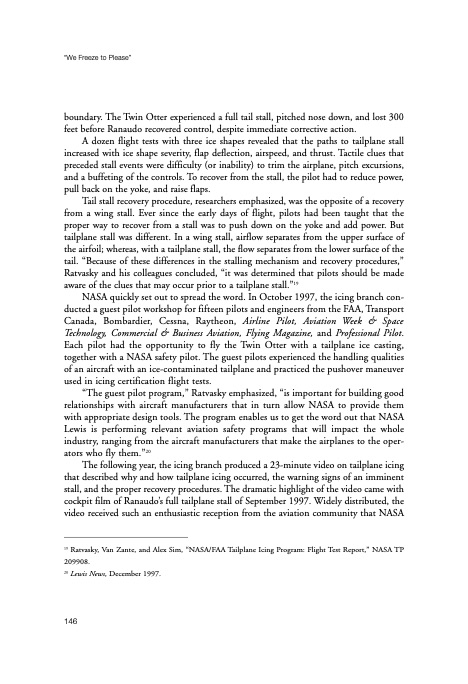
PDF Publication Title:
Text from PDF Page: 157
“We Freeze to Please” boundary. The Twin Otter experienced a full tail stall, pitched nose down, and lost 300 feet before Ranaudo recovered control, despite immediate corrective action. A dozen flight tests with three ice shapes revealed that the paths to tailplane stall increased with ice shape severity, flap deflection, airspeed, and thrust. Tactile clues that preceded stall events were difficulty (or inability) to trim the airplane, pitch excursions, and a buffeting of the controls. To recover from the stall, the pilot had to reduce power, pull back on the yoke, and raise flaps. Tail stall recovery procedure, researchers emphasized, was the opposite of a recovery from a wing stall. Ever since the early days of flight, pilots had been taught that the proper way to recover from a stall was to push down on the yoke and add power. But tailplane stall was different. In a wing stall, airflow separates from the upper surface of the airfoil; whereas, with a tailplane stall, the flow separates from the lower surface of the tail. “Because of these differences in the stalling mechanism and recovery procedures,” Ratvasky and his colleagues concluded, “it was determined that pilots should be made aware of the clues that may occur prior to a tailplane stall.”19 NASA quickly set out to spread the word. In October 1997, the icing branch con- ducted a guest pilot workshop for fifteen pilots and engineers from the FAA, Transport Canada, Bombardier, Cessna, Raytheon, Airline Pilot, Aviation Week & Space Technology, Commercial & Business Aviation, Flying Magazine, and Professional Pilot. Each pilot had the opportunity to fly the Twin Otter with a tailplane ice casting, together with a NASA safety pilot. The guest pilots experienced the handling qualities of an aircraft with an ice-contaminated tailplane and practiced the pushover maneuver used in icing certification flight tests. “The guest pilot program,” Ratvasky emphasized, “is important for building good relationships with aircraft manufacturers that in turn allow NASA to provide them with appropriate design tools. The program enables us to get the word out that NASA Lewis is performing relevant aviation safety programs that will impact the whole industry, ranging from the aircraft manufacturers that make the airplanes to the oper- ators who fly them.”20 The following year, the icing branch produced a 23-minute video on tailplane icing that described why and how tailplane icing occurred, the warning signs of an imminent stall, and the proper recovery procedures. The dramatic highlight of the video came with cockpit film of Ranaudo’s full tailplane stall of September 1997. Widely distributed, the video received such an enthusiastic reception from the aviation community that NASA 19 Ratvasky, Van Zante, and Alex Sim, “NASA/FAA Tailplane Icing Program: Flight Test Report,” NASA TP 209908. 20 Lewis News, December 1997. 146PDF Image | History of NASA Icing Research Tunnel

PDF Search Title:
History of NASA Icing Research TunnelOriginal File Name Searched:
sp4226.pdfDIY PDF Search: Google It | Yahoo | Bing
NFT (Non Fungible Token): Buy our tech, design, development or system NFT and become part of our tech NFT network... More Info
IT XR Project Redstone NFT Available for Sale: NFT for high tech turbine design with one part 3D printed counter-rotating energy turbine. Be part of the future with this NFT. Can be bought and sold but only one design NFT exists. Royalties go to the developer (Infinity) to keep enhancing design and applications... More Info
Infinity Turbine IT XR Project Redstone Design: NFT for sale... NFT for high tech turbine design with one part 3D printed counter-rotating energy turbine. Includes all rights to this turbine design, including license for Fluid Handling Block I and II for the turbine assembly and housing. The NFT includes the blueprints (cad/cam), revenue streams, and all future development of the IT XR Project Redstone... More Info
Infinity Turbine ROT Radial Outflow Turbine 24 Design and Worldwide Rights: NFT for sale... NFT for the ROT 24 energy turbine. Be part of the future with this NFT. This design can be bought and sold but only one design NFT exists. You may manufacture the unit, or get the revenues from its sale from Infinity Turbine. Royalties go to the developer (Infinity) to keep enhancing design and applications... More Info
Infinity Supercritical CO2 10 Liter Extractor Design and Worldwide Rights: The Infinity Supercritical 10L CO2 extractor is for botanical oil extraction, which is rich in terpenes and can produce shelf ready full spectrum oil. With over 5 years of development, this industry leader mature extractor machine has been sold since 2015 and is part of many profitable businesses. The process can also be used for electrowinning, e-waste recycling, and lithium battery recycling, gold mining electronic wastes, precious metals. CO2 can also be used in a reverse fuel cell with nafion to make a gas-to-liquids fuel, such as methanol, ethanol and butanol or ethylene. Supercritical CO2 has also been used for treating nafion to make it more effective catalyst. This NFT is for the purchase of worldwide rights which includes the design. More Info
NFT (Non Fungible Token): Buy our tech, design, development or system NFT and become part of our tech NFT network... More Info
Infinity Turbine Products: Special for this month, any plans are $10,000 for complete Cad/Cam blueprints. License is for one build. Try before you buy a production license. May pay by Bitcoin or other Crypto. Products Page... More Info
| CONTACT TEL: 608-238-6001 Email: greg@infinityturbine.com | RSS | AMP |